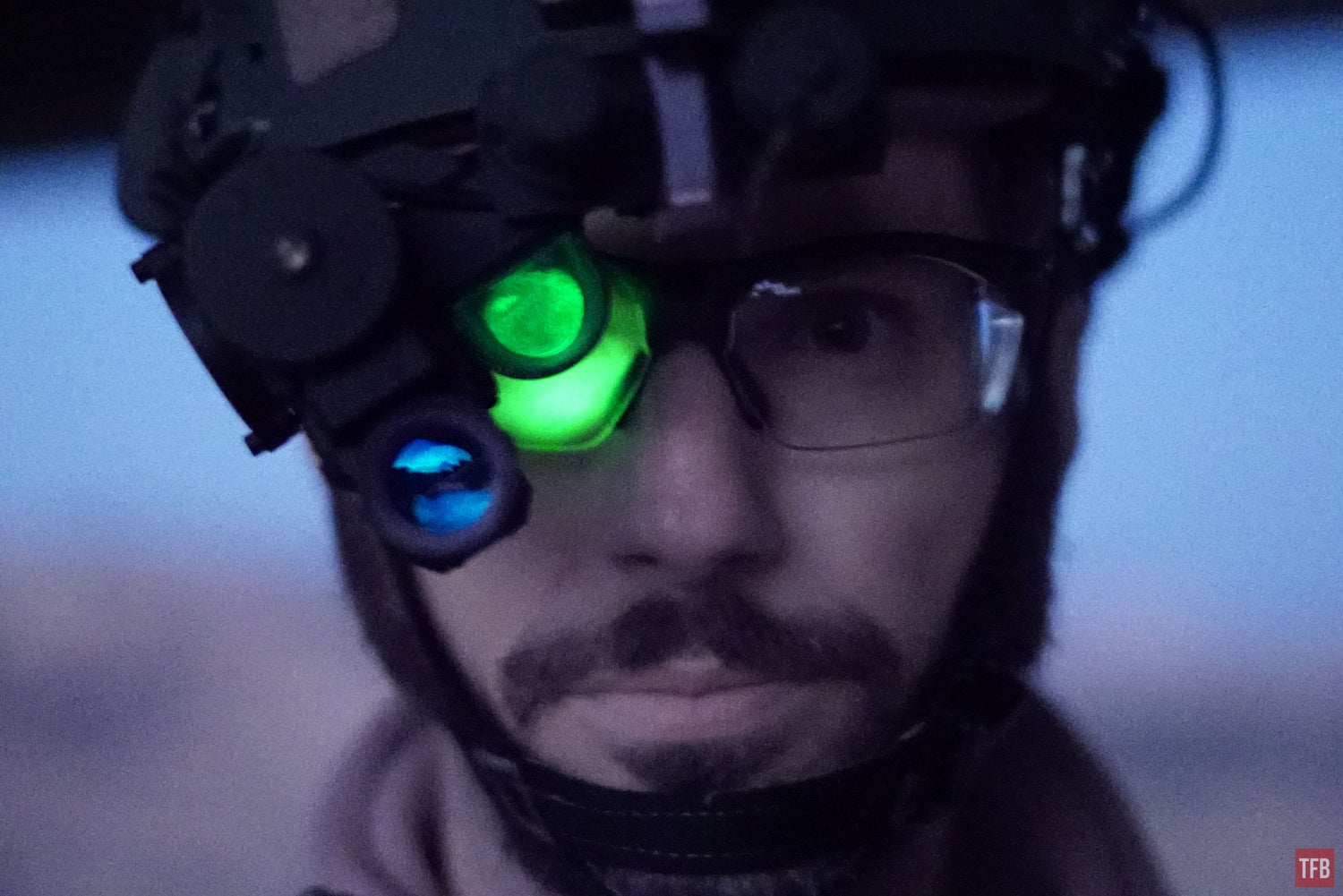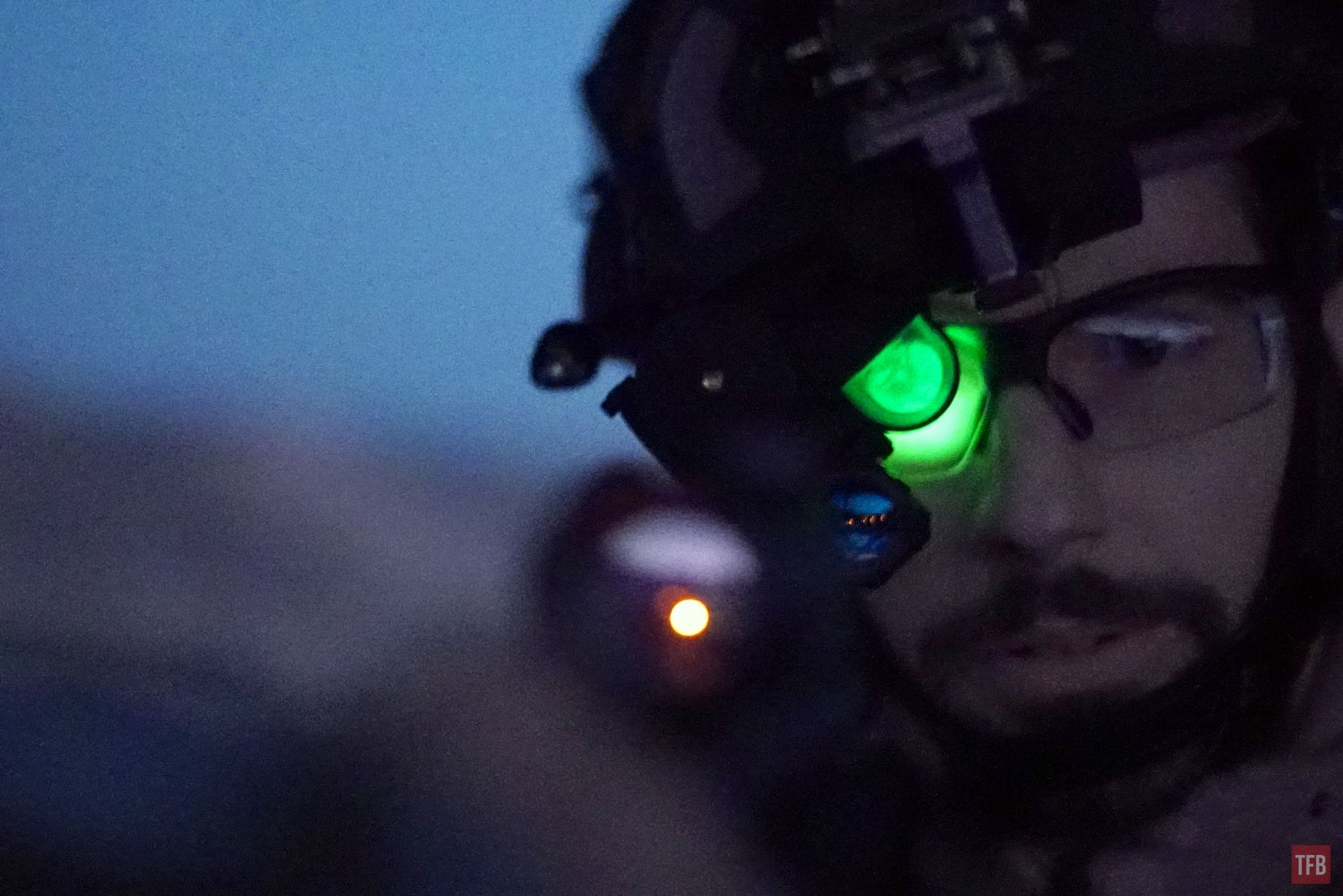Another week has passed and it is now Friday afternoon. Today we take a look at something we sort of looked at before – Steiner’s PVS-21. However, this is the Model 2740 LPNVM PVS-21 monocular. As always, Friday Night Lights is brought to you by ATN Corp, manufacturers of night vision and thermal optics like the THOR LT. As with all of our sponsored series, Friday Night Lights will continue to bring you unbiased news and reviews from a variety of companies.
Low Profile Night Vision @TFB:
- FRIDAY NIGHT LIGHTS: Steiner PVS-21 Low Profile Night Vision Goggles (LPNVG)
- Friday Night Lights: Norwegian SIMRAD GN1 – Biocular NVGs
- French Army Issues New THALES O-NYX Night Vision Goggles
LPNVM PVS-21 – A Tactical Monocle

The last time we looked at the PVS-21 was over two years ago thanks to my friend Aaron K. This time Jake G. lent me his recently acquired Model 2740 LPNVM (Low Profile Night Vision Monocular) PVS-21. In the photo above, you can see the dual tube PVS-21 above the monocular version PVS-21. The bino is simply the same airsoft replica that I had last time when I reviewed Aaron’s PVS-21s. He has since sold his PVS-21. Aside from that, the dummy PVS-21 shows you what a real PVS-21 should look like compared to the LPNVM PVS-21. The monocular version of the PVS-21 is simply a PVS-21 bino with the left side removed. When I tried Aaron’s PVS-21, I only had spent an hour behind them. This time I got to use the LPNVM for a lot longer and got to really see how the system works.
I used my Norotos AKA2 mount since it has more vertical adjustment than a Wilcox G24. The PVS-21 does not sit that low when using a G24.
Wilcox makes a tall dovetail for the PVS-21 for use with their G24 mounts. Aaron had one on his PVS-21. You can see it below highlighted in white.

The fit and finish on the PVS-21 does not seem like their DBAL lasers. The housing feels like MIM as opposed to machined aluminum. And there are globs of some epoxy all over the housing.

I am not sure why there are those bumps on this part of the housing. It is simply a cap that holds the IR illuminator and some parts of the image intensifier.

You can see the globs of epoxy here.



HUD Projection
One key feature of the PVS-21 night vision system is that you are not looking through the image intensifier. Instead, you are looking through a transparent beam splitter, sort of like a prism. This means you can see through and see the normal visible spectrum. You can see the HUD window positioned just above the objective lens in the photo below. The objective lens is the blue circle lens, and the HUD window is the horseshoe shape next to it.

Jake’s LPNVM PVS-21 was just like Aaron’s PVS-21s. They have a ruby filter stuck to the outside of the HUD window. This is to filter the night vision image which I will explain later. But it tints what you see through the HUD. The world looks pink through the rose-tinted filter and it severely limits the amount of light coming into the HUD window.


Thanks to Jake, he let me remove the pink eye filter. However, this causes light to leak out the front of the HUD window. As you can see in the photo below, the green light from the image intensifier is bounced off the HUD window to shine into your eye. The green light from the green phosphor bathes your eye and eye socket. This light then reflects forwards back out the HUD window. It is not very bright for natural eyesight but it can be picked up by night vision or in this case, I used a SiOnyx Aurora to take a selfie to show the green-eyed look.

My friend Kevin tried the PVS-21 monocular and the green glow from the HUD causes his eye pro to light up.

Model 2740 Features
The LPNVM PVS-21 is a bit heavy for a monocular. It is just over 1 lb.

The PVS-21 monocular comes in a pouch made by FirstSpear.

Interestingly, I don’t remember seeing Aaron’s PVS-21 come with these corn cushion looking sticky pads. These are to soften the feel of the bridge hitting your brow.

The eye relief of the HUD window is very shallow. In fact, I find that I need to push the LPNVM as close to my face as possible. Otherwise, the image is cropped out by the housing.
Double Vision
One of the misconceptions about the PVS-21 is the ability to “see through”. While in theory, you can “see through” it does not really work the way I would like. See the photos below. With the kitchen lights on, I can see both the visible light and the image intensified image. But there is an offset. That is simply due to the fact that the two images are offset, the HUD window vs the position of the objective lens.


When looking at objects closer to you, you can see a greater offset.


There is a benefit to seeing through the HUD window and that is to pick up color. In the photo below, I am looking at the gauges in my FJ Cruiser. I have the high beams on and the blue indicator light shines through the night vision image. The bright blobs of light are the same indicator lights being amplified by the image intensifier tube.

Shooting With LPNVM PVS-21
The main benefit to Model 2740 is that it is low profile. I recently acquired a Flux Defense Raider chassis for my SIG M17. Due to the optic placement, it is very difficult to try and aim passively with regular night vision.

In order to get a sight picture while wearing regular night vision, I have to roll my dominant eye side pod up and out of the way and use my eye to look through the optic.

You could pull your head further back but this is very uncomfortable.

With the LPVNM this is not a problem. You can see how close I can get to the optic and it will not touch.

In the photo above and below, I am aiming by looking through the HUD like window of the Model 2740.


Compare that to the photo below of Kevin aiming through a Trijicon MRO on his MP5. There are two ways to “aim passively” with the PVS-21. You can try and look through the HUD window and look for the dot, like I am aiming above. This works but since the objective lens sits below the HUD window, the gun blocks the lens. This would work better with a dual tube PVS-21 since your other objective lens would be unobstructed. However, I do not really see the need to aim using the HUD window lined up with a red dot. I rather pick up the red dot with the objective lens of the PVS-21.

Since the objective lens sits below the HUD window, it acts like an inverted periscope. This allows you to passively aim through optics that sit low on a gun. With absolute cowitness red dots, it is difficult to get traditional night vision behind the optic to aim. Not the case with the PVS-21.

In the photo below, I have the objective lens lined up with the Leupold LCO. The LCO is mounted on my CZ Scorpion Bullpup, however, I cannot get my cheek down far enough to aim through the LCO with my naked eye. I need a riser if I want to aim with my eyeballs. The PVS-21 design makes it much easier to aim passively.

Future Accessories
The design of the PVS-21 has the image bouncing around a series of mirrors and beam splitters. There is a port hole on the side of the housing for use with some augmentation. In the photo below, I have removed the port cover.

Steiner has two accessories that can interject images into the PVS-21. They make the CEHUD which allows you to interject images like maps and other visual information.

CEHUD. Photo by Steiner
Steiner also makes a COTM (Clip-On Thermal Module). It is similar to a COTI except instead of projecting the thermal image into the objective lens with a fiber optic periscope, the COTM projects the thermal image behind the image intensifier. So you get true thermal fusion with rear projection. This allows you to see the thermal image of a different color palette than the night vision image.

COTM. Photo by Steiner
I did try adding a Jerry-C to the LPNVM. The objective lens is too small but I was able to test if it could work.


The Model 2740 did not come with a day filter so I made one out of a PVS-14 objective lens cover. The objective lens on the LPNVM is rather small in diameter so usual lens covers will not fit. By pure luck, the rear cap that comes on PVS-14 objective lenses, when you buy them separately from the manufacturer, happens to fit the PVS-21.


I had to cut a slot for the objective focus stop lobe and drilled a hole in the middle so I can use the PVS-21 in the day time I need to. 
PVS-21 Wrap Up
I like the LPVM PVS-21 more than the dual tube version. The phoropter-like design of the PVS-21 blocks a lot of your side peripheral vision. Especially since you have to have the HUD window sit really close to your eye. The ruby filter makes sense but severely limits your ability to see through the HUD window that I make the compromise to not use it. I prefer removing the ruby filter just so more light can enter the HUD window.
The “see through” concept does not really work that well if the image intensifier is turned on. Shutting off the PVS-21 allows it to be much easier to see visible light through the HUD window. I am not sure why but the HUD window is still tinted so it reduces some light coming in, making it harder to see in lower light areas.
The PVS-21 is powered by a single AA battery and according to Steiner it has a run time of 8-12 hours with an Alkaline AA battery. I was hoping it would be similar to a PVS-14 and somewhere in the 40-hour run time range but unfortunately it is not. The one huge benefit to the PVS-21 design is its low-profile nature and the position of the objective lens. You can get behind guns and optics a lot easier with the PVS-21 than you can with traditional night vision devices. Unfortunately, the MSRP price for a PVS-21 bino is rather high. Steiner wants $21k for a PVS-21. And almost $11k for the monocular. You can find the bino second hand for around $4k-$6k. This monocular Model 2740 is the only one I have seen for sale since I got into night vision. So it is rather uncommon and Jake got it at a decent price, about the same for a quality PVS-14. Huge thanks to Jake for letting me borrow it and thanks to Kevin for helping me test it. For more information check out Steiner’s website.
 Your Privacy Choices
Your Privacy Choices








